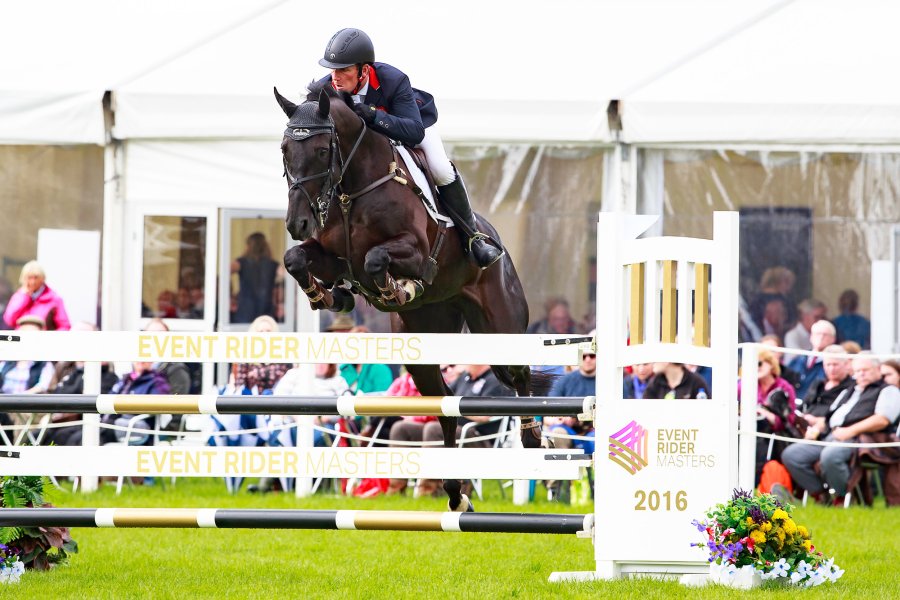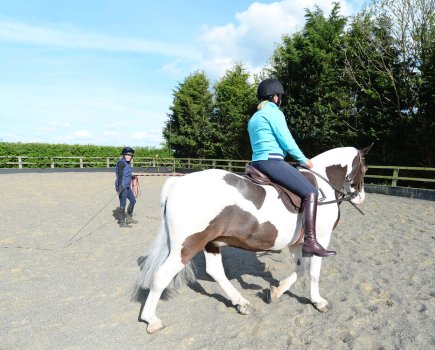The best horse and rider partnerships look seamless, because their communication is so refined it’s almost impossible to detect. This is only possible through correct training, which includes teaching your horse to respond to the subtlest changes in your body language.
Showjumper Geoff Billington and eventer Oliver Townend discussed this during their demonstration in the SEIB Arena at Your Horse Live.
Geoff, who’s ridden over 50 Nations Cups for Great Britain, was riding Grand Prix jumper Just Special, who he’s been riding since the stallion was a four-year-old.
“My wife Sarah rode him as a four and five year old, and for half of his six year old year, then I took him over,” explained Geoff as he brought the beautiful eight-year-old grey out. “It takes years to get to know a horse properly. He knows exactly what I want. If I want to stop, all I do is sit down and lean back, and a touch on his mouth.”
Many riders focus on their rein and leg aids, but forget about the role their seat and bodyweight play in communicating to their horse.
“We’ve got to get the horse listening to your upper body weight; you want to regulate the horse’s pace by just slightly leaning forwards and leaning back,” explained Geoff. “You should be able to sit down, lean back and the horse stop.”
As he points out, you don’t often see the top riders pulling their horses around – especially not heading into the bigger fences. You don’t want to have an argument with your horse about slowing down into a jump or coming on the correct line between fences, whether the jumps are 60cm or 1.60m.
“When you’re watching Scott Brash, it looks like he’s doing nothing. But all he’s got to do is move his body from there to there,” said Geoff, demonstrating moving his shoulders from slightly in front to slightly behind his hips. “You can hardly see it. But when you’ve got the horse finely tuned, they’ll listen to it.”
The role of the rider
As the duo warm up through the paces, Oliver talks about what he expects from his horses. He was on board Comfort, a breeding stallion owned by Caunton Manor Stud.
“For me, it’s all about getting the horse to do as much of the work as possible by themselves,” he said. “All the time I have a light contact, sitting in the middle, just quietly asking the same things again and again.”
To train for subtle aids you must apply subtle aids – you can’t expect your horse to respond to a gentle squeeze in the ring if you have to kick them around the course at home.
“When you ask for canter, it’s no more pressure than changing channel on the TV remote,” said Oliver, popping Comfort up into an easy canter. “You can do lots of moving around and changes of gear. I’ll quietly move him forwards, quietly bring him back, then quietly move him forwards. It’s all from my body language. I go forwards, soften my seat, tighten my stomach and my backside and he comes back. It’s about getting them as adjustable as possible.”
It’s just not just about rideability – it’ll make the experience more enjoyable for your horse, too, and they’ll therefore be more willing to work.
“It’s a lot easier to make friends with your horse than make war,” said Geoff. “When horses start doing funny things, 98% of the time it’s the rider that’s making the problem.
“If we can do things consistently then the horse gets used to what we want. So canter, sit down, lean back – that’s how you want to start.”
As the jumps get higher, it can be tempting to ‘over-ride’ in an attempt to feel like you’re more likely to make it over. But the best thing to do is carry on riding as you are, and continue to train your horse to respond to the subtlest of aids.
“As the fences get bigger, we don’t do anything differently,” said Geoff. “If you can get it correct, smooth and in balance over a smaller height, you don’t do anything differently as the fences go bigger. It doesn’t matter if they are 1.20m, 1.30m, 1.50m or 1.60m.”
Riding with one hand
If you find yourself struggling to give with the hand, Geoff recommends trying riding with one hand to re-train yourself.
“I think if you practise riding one handed, it eliminates a lot of problems. Some riders are too busy with their hands, and the horse is saying ‘what does he want?’,” said Geoff, demonstrating on a loose rein moving his hands around a lot. “If I see someone doing this like they’re on a tightrope, I’ll make them put the reins in one hand. If you ride with one hand, you’ve got to steer the horse with your legs.”
Cheekily, he also noted another thing riding one-handed is helpful for.
“I practise riding with one hand so I can have a drink in the other,” joked Geoff. “It’s worked well over the years.”
Meet the experts: Eventer Oliver Townend is a former FEI world number one ranked rider. He has won Badminton, Burghley and Kentucky – the latter two on multiple occasions – as well as medalling at European Championships and the Tokyo Olympic Games.
Showjumper Geoff Billington has ridden in over 50 Nations Cups for Great Britain, as well as representing his country in the Atlanta and Sydney Olympics in 1996 and 2000. He won team bronze in the 1997 European Championships and individual and team bronze at the 1998 World Championships.
Lead image: Oliver Townend riding Cillnabradden Evo in the CIC3* Event Rider Masters Showjumping at 2016 Blair Castle Interntional Horse Trial. Sunday 28 August (Interim-1ST). © Libby Law Photography








